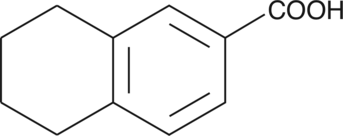Cayman
Showing 6751–6900 of 45550 results
-
Signal transducer and activator of transcription 3 (STAT3) is a cytokine-inducible transcription factor with roles in inflammation and cancer.{7286,11981} 5,15-DPP is a cell-permeable porphyrin derivative that selectively binds STAT3 (Kd = 880 nM).{26153} This inhibits STAT3 dimerization via Src homology 2 (Sh2) domains (IC50 = 280 nM), preventing nuclear translocation and DNA binding.{26153} 5,15-DPP poorly inhibits STAT1 (IC50 = 10 µM) and does not affect Grb2.{26153} It reduces IL-6-dependent STAT3 activation and consequent c-myc expression in MDA-MB-468 cells and blocks TRAIL-induced migration and invasion in A549 cells.{26153,26154} Furthermore, inhibition of JAK/STAT signaling in satellite cells via 5,15-DPP and the JAK2 inhibitor AG-490 (Item No. 10010311) has been used to stimulate muscle regeneration in a model of aging skeletal muscle deterioration.{27730}
Brand:CaymanSKU:-5,6-dehydro Arachidonic acid is an analog of arachidonic acid with an acetylene in the 5,6 position. It inhibits 5-LO in rat basophilic leukemia cells, with a Ki value of 15 µM.{4049} In guinea pig leukocytes, 5-LO is inhibited by 5,6-dehydro arachidonic acid with an IC50 value of 10 µM.{472}
Brand:CaymanSKU:90020 - 100 µgAvailable on backorder
5,6-dehydro Arachidonic acid is an analog of arachidonic acid with an acetylene in the 5,6 position. It inhibits 5-LO in rat basophilic leukemia cells, with a Ki value of 15 µM.{4049} In guinea pig leukocytes, 5-LO is inhibited by 5,6-dehydro arachidonic acid with an IC50 value of 10 µM.{472}
Brand:CaymanSKU:90020 - 25 µgAvailable on backorder
5,6-dehydro Arachidonic acid is an analog of arachidonic acid with an acetylene in the 5,6 position. It inhibits 5-LO in rat basophilic leukemia cells, with a Ki value of 15 µM.{4049} In guinea pig leukocytes, 5-LO is inhibited by 5,6-dehydro arachidonic acid with an IC50 value of 10 µM.{472}
Brand:CaymanSKU:90020 - 50 µgAvailable on backorder
5,6-dihydro-5-Fluorouracil (5-FUH2) is formed by the hydrogenation of 5-fluorouracil (5-FU; Item No. 14416) via the enzyme dihydropyrimidine dehydrogenase (DPD).{34392} Formulations containing 5-FU are used for the treatment of cancer. However, in patients lacking full DPD activity, severe adverse events, including death, can occur. 5-FUH2 is less toxic than 5-FU but is not as effective (IC50s = 3.3 and 560 µM for 5-FU and 5-FUH2, respectively in WiDr human colon cancer cells).{34391}
Brand:CaymanSKU:20977 -Out of stock
5,6-dihydro-5-Fluorouracil (5-FUH2) is formed by the hydrogenation of 5-fluorouracil (5-FU; Item No. 14416) via the enzyme dihydropyrimidine dehydrogenase (DPD).{34392} Formulations containing 5-FU are used for the treatment of cancer. However, in patients lacking full DPD activity, severe adverse events, including death, can occur. 5-FUH2 is less toxic than 5-FU but is not as effective (IC50s = 3.3 and 560 µM for 5-FU and 5-FUH2, respectively in WiDr human colon cancer cells).{34391}
Brand:CaymanSKU:20977 -Out of stock
5,6-dihydro-5-Fluorouracil (5-FUH2) is formed by the hydrogenation of 5-fluorouracil (5-FU; Item No. 14416) via the enzyme dihydropyrimidine dehydrogenase (DPD).{34392} Formulations containing 5-FU are used for the treatment of cancer. However, in patients lacking full DPD activity, severe adverse events, including death, can occur. 5-FUH2 is less toxic than 5-FU but is not as effective (IC50s = 3.3 and 560 µM for 5-FU and 5-FUH2, respectively in WiDr human colon cancer cells).{34391}
Brand:CaymanSKU:20977 -Out of stock
5,6-dihydro-5-Fluorouracil (5-FUH2) is formed by the hydrogenation of 5-fluorouracil (5-FU; Item No. 14416) via the enzyme dihydropyrimidine dehydrogenase (DPD).{34392} Formulations containing 5-FU are used for the treatment of cancer. However, in patients lacking full DPD activity, severe adverse events, including death, can occur. 5-FUH2 is less toxic than 5-FU but is not as effective (IC50s = 3.3 and 560 µM for 5-FU and 5-FUH2, respectively in WiDr human colon cancer cells).{34391}
Brand:CaymanSKU:20977 -Out of stock
5,6-dihydroxy Indole is an intermediate in melanogenesis.{32499,32500} Its precursor is dopachrome. 5,6-dihydroxy Indole can be metabolized to either eumelanin or pheomelanin, depending, in part, on the availability of cysteine.
Brand:CaymanSKU:20630 -Available on backorder
5,6-dihydroxy Indole is an intermediate in melanogenesis.{32499,32500} Its precursor is dopachrome. 5,6-dihydroxy Indole can be metabolized to either eumelanin or pheomelanin, depending, in part, on the availability of cysteine.
Brand:CaymanSKU:20630 -Available on backorder
5,6-dihydroxy Indole is an intermediate in melanogenesis.{32499,32500} Its precursor is dopachrome. 5,6-dihydroxy Indole can be metabolized to either eumelanin or pheomelanin, depending, in part, on the availability of cysteine.
Brand:CaymanSKU:20630 -Available on backorder
5,6-dihydroxy Indole is an intermediate in melanogenesis.{32499,32500} Its precursor is dopachrome. 5,6-dihydroxy Indole can be metabolized to either eumelanin or pheomelanin, depending, in part, on the availability of cysteine.
Brand:CaymanSKU:20630 -Available on backorder
5,6-dimethyl-2-Thiouracil is a heterocyclic building block that has been used in the synthesis of anti-HIV-1 pyrimidinones.{53342} It has also been used as an internal standard for the quantification of thyreostats, including 2-thiouracil, in bovine plasma.{53343}
Brand:CaymanSKU:29821 - 1 gAvailable on backorder
5,6-dimethyl-2-Thiouracil is a heterocyclic building block that has been used in the synthesis of anti-HIV-1 pyrimidinones.{53342} It has also been used as an internal standard for the quantification of thyreostats, including 2-thiouracil, in bovine plasma.{53343}
Brand:CaymanSKU:29821 - 5 gAvailable on backorder
5,6-dimethyl-2-Thiouracil is a heterocyclic building block that has been used in the synthesis of anti-HIV-1 pyrimidinones.{53342} It has also been used as an internal standard for the quantification of thyreostats, including 2-thiouracil, in bovine plasma.{53343}
Brand:CaymanSKU:29821 - 500 mgAvailable on backorder
5,6-epoxy-13-cis Retinoic acid is a metabolite of 13-cis retinoic acid.{41119} It is formed when 13-cis retinoic acid undergoes cooxidation by prostaglandin H (PGH) synthase in the presence of hydroperoxides or peroxyl radicals. 5,6-epoxy-13-cis Retinoic acid is also a potential impurity found in commercial preparations of 13-cis retinoic acid.{41120}
Brand:CaymanSKU:23091 - 1 mgAvailable on backorder
5,6-epoxy-13-cis Retinoic acid is a metabolite of 13-cis retinoic acid.{41119} It is formed when 13-cis retinoic acid undergoes cooxidation by prostaglandin H (PGH) synthase in the presence of hydroperoxides or peroxyl radicals. 5,6-epoxy-13-cis Retinoic acid is also a potential impurity found in commercial preparations of 13-cis retinoic acid.{41120}
Brand:CaymanSKU:23091 - 500 µgAvailable on backorder
5,6-trans-Vitamin D3 is an isomer of vitamin D3 (Item No. 11792).{54489} In vivo, 5,6-trans-vitamin D3 (1, 3, and 10 µg/day) increases tibia ash weight and bone mineralization in vitamin D-deficient chicks. 5,6-trans-Vitamin D3 (25 µg/animal) induces intestinal calcium transport and bone calcium mobilization in anephric rats fed a low-calcium and vitamin D-deficient diet.{54490}
Brand:CaymanSKU:31225 - 1 mgAvailable on backorder
5,6-trans-Vitamin D3 is an isomer of vitamin D3 (Item No. 11792).{54489} In vivo, 5,6-trans-vitamin D3 (1, 3, and 10 µg/day) increases tibia ash weight and bone mineralization in vitamin D-deficient chicks. 5,6-trans-Vitamin D3 (25 µg/animal) induces intestinal calcium transport and bone calcium mobilization in anephric rats fed a low-calcium and vitamin D-deficient diet.{54490}
Brand:CaymanSKU:31225 - 10 mgAvailable on backorder
5,6-trans-Vitamin D3 is an isomer of vitamin D3 (Item No. 11792).{54489} In vivo, 5,6-trans-vitamin D3 (1, 3, and 10 µg/day) increases tibia ash weight and bone mineralization in vitamin D-deficient chicks. 5,6-trans-Vitamin D3 (25 µg/animal) induces intestinal calcium transport and bone calcium mobilization in anephric rats fed a low-calcium and vitamin D-deficient diet.{54490}
Brand:CaymanSKU:31225 - 5 mgAvailable on backorder
5,6,7,8-tetrahydro-2-Naphthoic Acid is a synthetic intermediate useful for pharmaceutical synthesis.
Brand:CaymanSKU:10007131 - 1 gAvailable on backorder
5,6,7,8-tetrahydro-2-Naphthoic Acid is a synthetic intermediate useful for pharmaceutical synthesis.
Brand:CaymanSKU:10007131 - 5 gAvailable on backorder
5,6,7,8-tetrahydro-2-Naphthoic Acid is a synthetic intermediate useful for pharmaceutical synthesis.
Brand:CaymanSKU:10007131 - 500 mgAvailable on backorder
5,6,7,8-tetrahydro-2(1H)-Quinolinone is a synthetic intermediate useful for pharmaceutical synthesis.
Brand:CaymanSKU:10007083 - 1 gAvailable on backorder
5,6,7,8-tetrahydro-2(1H)-Quinolinone is a synthetic intermediate useful for pharmaceutical synthesis.
Brand:CaymanSKU:10007083 - 100 mgAvailable on backorder
5,6,7,8-tetrahydro-2(1H)-Quinolinone is a synthetic intermediate useful for pharmaceutical synthesis.
Brand:CaymanSKU:10007083 - 50 mgAvailable on backorder
5,6,7,8-tetrahydro-2(1H)-Quinolinone is a synthetic intermediate useful for pharmaceutical synthesis.
Brand:CaymanSKU:10007083 - 500 mgAvailable on backorder
5,7-dichloro Tryptamine is a ring-substituted tryptamine derivative. Although the biological effects of this compound have not been reported, tryptamines substituted with fluorine at the 5-, 6-, or 7-position have been shown to have 5-HT2C receptor selectivity over both the 5-HT2A and 5-HT2B subtypes.{29113,25254} This product is intended for forensic and research applications.
Brand:CaymanSKU:-Available on backorder
5,7-dichloro Tryptamine is a ring-substituted tryptamine derivative. Although the biological effects of this compound have not been reported, tryptamines substituted with fluorine at the 5-, 6-, or 7-position have been shown to have 5-HT2C receptor selectivity over both the 5-HT2A and 5-HT2B subtypes.{29113,25254} This product is intended for forensic and research applications.
Brand:CaymanSKU:-Available on backorder
5,7-dichloro Tryptamine is a ring-substituted tryptamine derivative. Although the biological effects of this compound have not been reported, tryptamines substituted with fluorine at the 5-, 6-, or 7-position have been shown to have 5-HT2C receptor selectivity over both the 5-HT2A and 5-HT2B subtypes.{29113,25254} This product is intended for forensic and research applications.
Brand:CaymanSKU:-Available on backorder
5,7-dichloro Tryptamine is a ring-substituted tryptamine derivative. Although the biological effects of this compound have not been reported, tryptamines substituted with fluorine at the 5-, 6-, or 7-position have been shown to have 5-HT2C receptor selectivity over both the 5-HT2A and 5-HT2B subtypes.{29113,25254} This product is intended for forensic and research applications.
Brand:CaymanSKU:-Available on backorder
5,7-Dichlorokyneurenic acid (5,7-DCKA) is a derivative of kynurenic acid (Item No. 16792) and an NMDA receptor antagonist (Ki = 40 nM in a radioligand binding assay).{41941} It selectively inhibits glycine- over kainate-induced NDMA currents at 15 μM in Xenopus oocytes expressing rat NMDA receptors. 5,7-DCKA reduces NMDA-induced neurotoxicity in primary rat cortical neurons by 55 to 90% when used at concentrations ranging from 1 to 10 μM. In vivo, 5,7-DCKA (0.97-97 nmol) reverses mechanical hyperalgesia in magnesium-deficient rats in a dose-dependent manner.{41942} It blocks the positive ionotropic effect, hypertension, and increase in myocardial oxygen demand induced by electrical stimulation of the paraventricular nucleus (PVN) in anesthetized rabbits.{41943} 5,7-DCKA also increases social interaction time in the social interaction test and time spent in the open arms of the elevated plus maze, indicating anxiolytic-like activity, as well as disinhibits conflict responding in the Cook and Davidson conditioned conflict paradigm.{41944}
Brand:CaymanSKU:25533 - 10 mgAvailable on backorder
5,7-Dichlorokyneurenic acid (5,7-DCKA) is a derivative of kynurenic acid (Item No. 16792) and an NMDA receptor antagonist (Ki = 40 nM in a radioligand binding assay).{41941} It selectively inhibits glycine- over kainate-induced NDMA currents at 15 μM in Xenopus oocytes expressing rat NMDA receptors. 5,7-DCKA reduces NMDA-induced neurotoxicity in primary rat cortical neurons by 55 to 90% when used at concentrations ranging from 1 to 10 μM. In vivo, 5,7-DCKA (0.97-97 nmol) reverses mechanical hyperalgesia in magnesium-deficient rats in a dose-dependent manner.{41942} It blocks the positive ionotropic effect, hypertension, and increase in myocardial oxygen demand induced by electrical stimulation of the paraventricular nucleus (PVN) in anesthetized rabbits.{41943} 5,7-DCKA also increases social interaction time in the social interaction test and time spent in the open arms of the elevated plus maze, indicating anxiolytic-like activity, as well as disinhibits conflict responding in the Cook and Davidson conditioned conflict paradigm.{41944}
Brand:CaymanSKU:25533 - 25 mgAvailable on backorder
5,7-Dichlorokyneurenic acid (5,7-DCKA) is a derivative of kynurenic acid (Item No. 16792) and an NMDA receptor antagonist (Ki = 40 nM in a radioligand binding assay).{41941} It selectively inhibits glycine- over kainate-induced NDMA currents at 15 μM in Xenopus oocytes expressing rat NMDA receptors. 5,7-DCKA reduces NMDA-induced neurotoxicity in primary rat cortical neurons by 55 to 90% when used at concentrations ranging from 1 to 10 μM. In vivo, 5,7-DCKA (0.97-97 nmol) reverses mechanical hyperalgesia in magnesium-deficient rats in a dose-dependent manner.{41942} It blocks the positive ionotropic effect, hypertension, and increase in myocardial oxygen demand induced by electrical stimulation of the paraventricular nucleus (PVN) in anesthetized rabbits.{41943} 5,7-DCKA also increases social interaction time in the social interaction test and time spent in the open arms of the elevated plus maze, indicating anxiolytic-like activity, as well as disinhibits conflict responding in the Cook and Davidson conditioned conflict paradigm.{41944}
Brand:CaymanSKU:25533 - 5 mgAvailable on backorder
5,7-Dichlorokyneurenic acid (5,7-DCKA) is a derivative of kynurenic acid (Item No. 16792) and an NMDA receptor antagonist (Ki = 40 nM in a radioligand binding assay).{41941} It selectively inhibits glycine- over kainate-induced NDMA currents at 15 μM in Xenopus oocytes expressing rat NMDA receptors. 5,7-DCKA reduces NMDA-induced neurotoxicity in primary rat cortical neurons by 55 to 90% when used at concentrations ranging from 1 to 10 μM. In vivo, 5,7-DCKA (0.97-97 nmol) reverses mechanical hyperalgesia in magnesium-deficient rats in a dose-dependent manner.{41942} It blocks the positive ionotropic effect, hypertension, and increase in myocardial oxygen demand induced by electrical stimulation of the paraventricular nucleus (PVN) in anesthetized rabbits.{41943} 5,7-DCKA also increases social interaction time in the social interaction test and time spent in the open arms of the elevated plus maze, indicating anxiolytic-like activity, as well as disinhibits conflict responding in the Cook and Davidson conditioned conflict paradigm.{41944}
Brand:CaymanSKU:25533 - 50 mgAvailable on backorder
5,7-Dihydroxychromone is a flavone decomposition product that has been found in A. hypogaea and has diverse biological activities, including antimicrobial, antioxidant, and neuroprotective properties.{48623,48624} It reduces radial growth of the soil pathogenic fungi R. solani and S. rolfsii (IC50s = 18 and 26 µM, respectively) but has no effect on soil pathogenic bacteria of the genus Bradyrhizobium.{48623} 5,7-Dihydroxychromone (0.4, 2, and 10 µM) reduces increases in apoptosis and the levels of reactive oxygen species (ROS) induced by 6-OHDA (Item No. 25330) in SH-SY5Y neuroblastoma cells. It also increases the levels of HO-1, NQO1, and GCLc in SH-SY5Y cells when used at concentrations ranging from 0.08 to 10 µM.{48624}
Brand:CaymanSKU:29006 - 1 mgAvailable on backorder
5,7-Dihydroxychromone is a flavone decomposition product that has been found in A. hypogaea and has diverse biological activities, including antimicrobial, antioxidant, and neuroprotective properties.{48623,48624} It reduces radial growth of the soil pathogenic fungi R. solani and S. rolfsii (IC50s = 18 and 26 µM, respectively) but has no effect on soil pathogenic bacteria of the genus Bradyrhizobium.{48623} 5,7-Dihydroxychromone (0.4, 2, and 10 µM) reduces increases in apoptosis and the levels of reactive oxygen species (ROS) induced by 6-OHDA (Item No. 25330) in SH-SY5Y neuroblastoma cells. It also increases the levels of HO-1, NQO1, and GCLc in SH-SY5Y cells when used at concentrations ranging from 0.08 to 10 µM.{48624}
Brand:CaymanSKU:29006 - 10 mgAvailable on backorder
5,7-Dihydroxychromone is a flavone decomposition product that has been found in A. hypogaea and has diverse biological activities, including antimicrobial, antioxidant, and neuroprotective properties.{48623,48624} It reduces radial growth of the soil pathogenic fungi R. solani and S. rolfsii (IC50s = 18 and 26 µM, respectively) but has no effect on soil pathogenic bacteria of the genus Bradyrhizobium.{48623} 5,7-Dihydroxychromone (0.4, 2, and 10 µM) reduces increases in apoptosis and the levels of reactive oxygen species (ROS) induced by 6-OHDA (Item No. 25330) in SH-SY5Y neuroblastoma cells. It also increases the levels of HO-1, NQO1, and GCLc in SH-SY5Y cells when used at concentrations ranging from 0.08 to 10 µM.{48624}
Brand:CaymanSKU:29006 - 5 mgAvailable on backorder
5,8,11-ETI is a nonselective inhibitor of lipoxygenases. It inhibits 12-LO in human platelets with an ID50 value of 24 µM.{66} 5,8,11-ETI also inhibits A23187 and L-cysteine induced LTC4 biosynthesis in mouse mastocytoma cells with an ID50 value of 5 µM.{650} At higher concentrations, 5,8,11-ETI also inhibits cyclooxygenases (ID50 = 340 µM).{66}
Brand:CaymanSKU:90200 - 1 mgAvailable on backorder
5,8,11-ETI is a nonselective inhibitor of lipoxygenases. It inhibits 12-LO in human platelets with an ID50 value of 24 µM.{66} 5,8,11-ETI also inhibits A23187 and L-cysteine induced LTC4 biosynthesis in mouse mastocytoma cells with an ID50 value of 5 µM.{650} At higher concentrations, 5,8,11-ETI also inhibits cyclooxygenases (ID50 = 340 µM).{66}
Brand:CaymanSKU:90200 - 10 mgAvailable on backorder
5,8,11-ETI is a nonselective inhibitor of lipoxygenases. It inhibits 12-LO in human platelets with an ID50 value of 24 µM.{66} 5,8,11-ETI also inhibits A23187 and L-cysteine induced LTC4 biosynthesis in mouse mastocytoma cells with an ID50 value of 5 µM.{650} At higher concentrations, 5,8,11-ETI also inhibits cyclooxygenases (ID50 = 340 µM).{66}
Brand:CaymanSKU:90200 - 5 mgAvailable on backorder
5′-(N-Cyclopropyl)carboxamidoadenosine is a specific adenosine A2 receptor agonist with antipyretic and anticonvulsant activity.{29436,29437} It stimulates the production of cyclic AMP in CHO-K1 cells with an EC50 value of 5.3 µM.{29438}
Brand:CaymanSKU:-Available on backorder
5′-(N-Cyclopropyl)carboxamidoadenosine is a specific adenosine A2 receptor agonist with antipyretic and anticonvulsant activity.{29436,29437} It stimulates the production of cyclic AMP in CHO-K1 cells with an EC50 value of 5.3 µM.{29438}
Brand:CaymanSKU:-Available on backorder
5′-(N-Cyclopropyl)carboxamidoadenosine is a specific adenosine A2 receptor agonist with antipyretic and anticonvulsant activity.{29436,29437} It stimulates the production of cyclic AMP in CHO-K1 cells with an EC50 value of 5.3 µM.{29438}
Brand:CaymanSKU:-Available on backorder
5′-(N-Cyclopropyl)carboxamidoadenosine is a specific adenosine A2 receptor agonist with antipyretic and anticonvulsant activity.{29436,29437} It stimulates the production of cyclic AMP in CHO-K1 cells with an EC50 value of 5.3 µM.{29438}
Brand:CaymanSKU:-Available on backorder
5′-chloro-5′-Deoxyadenosine (hydrate) is a nucleoside analog used as a substrate in polyketide biosynthesis. S-(5’-adenosyl)-L-methionine (SAM; Item No. 13956) can be converted to 5’-chloro-5’-deoxyadenosine in a reaction catalyzed by a SAM-dependent chlorinase.{32994} Through a 7-step route, 5′-chloro-5′-deoxyadenosine can be converted to chloroethylmalonyl-CoA, which has been shown to be involved in the biosynthesis of the anticancer agent salinosporamide A (Item No. 10007311) in the marine bacterium S. tropica.{32994}
Brand:CaymanSKU:21012 -Out of stock
5′-chloro-5′-Deoxyadenosine (hydrate) is a nucleoside analog used as a substrate in polyketide biosynthesis. S-(5’-adenosyl)-L-methionine (SAM; Item No. 13956) can be converted to 5’-chloro-5’-deoxyadenosine in a reaction catalyzed by a SAM-dependent chlorinase.{32994} Through a 7-step route, 5′-chloro-5′-deoxyadenosine can be converted to chloroethylmalonyl-CoA, which has been shown to be involved in the biosynthesis of the anticancer agent salinosporamide A (Item No. 10007311) in the marine bacterium S. tropica.{32994}
Brand:CaymanSKU:21012 -Out of stock
5′-chloro-5′-Deoxyadenosine (hydrate) is a nucleoside analog used as a substrate in polyketide biosynthesis. S-(5’-adenosyl)-L-methionine (SAM; Item No. 13956) can be converted to 5’-chloro-5’-deoxyadenosine in a reaction catalyzed by a SAM-dependent chlorinase.{32994} Through a 7-step route, 5′-chloro-5′-deoxyadenosine can be converted to chloroethylmalonyl-CoA, which has been shown to be involved in the biosynthesis of the anticancer agent salinosporamide A (Item No. 10007311) in the marine bacterium S. tropica.{32994}
Brand:CaymanSKU:21012 -Out of stock
5′-chloro-5′-Deoxyadenosine (hydrate) is a nucleoside analog used as a substrate in polyketide biosynthesis. S-(5’-adenosyl)-L-methionine (SAM; Item No. 13956) can be converted to 5’-chloro-5’-deoxyadenosine in a reaction catalyzed by a SAM-dependent chlorinase.{32994} Through a 7-step route, 5′-chloro-5′-deoxyadenosine can be converted to chloroethylmalonyl-CoA, which has been shown to be involved in the biosynthesis of the anticancer agent salinosporamide A (Item No. 10007311) in the marine bacterium S. tropica.{32994}
Brand:CaymanSKU:21012 -Out of stock
The pyrimidine thymidine consists of thymine combined with deoxyribose. Prior to polymerization into DNA, thymidine must be phosphorylated at the hydroxyl group on carbon 5 of the ribose moiety. 5′-deoxy Thymidine is a form of thymidine in which the hydroxyl group on carbon 5 of ribose has been replaced with hydrogen. As a result, this compound cannot be phosphorylated and used by DNA polymerase in the synthesis of DNA. 5′-deoxy Thymidine is readily imported by cellular nucleoside importers and competitively inhibits the influx of thymidine.{29379} It demonstrates antibacterial activity against B. subtilis and S. aureus.{29380}
Brand:CaymanSKU:-Available on backorder
The pyrimidine thymidine consists of thymine combined with deoxyribose. Prior to polymerization into DNA, thymidine must be phosphorylated at the hydroxyl group on carbon 5 of the ribose moiety. 5′-deoxy Thymidine is a form of thymidine in which the hydroxyl group on carbon 5 of ribose has been replaced with hydrogen. As a result, this compound cannot be phosphorylated and used by DNA polymerase in the synthesis of DNA. 5′-deoxy Thymidine is readily imported by cellular nucleoside importers and competitively inhibits the influx of thymidine.{29379} It demonstrates antibacterial activity against B. subtilis and S. aureus.{29380}
Brand:CaymanSKU:-Available on backorder
The pyrimidine thymidine consists of thymine combined with deoxyribose. Prior to polymerization into DNA, thymidine must be phosphorylated at the hydroxyl group on carbon 5 of the ribose moiety. 5′-deoxy Thymidine is a form of thymidine in which the hydroxyl group on carbon 5 of ribose has been replaced with hydrogen. As a result, this compound cannot be phosphorylated and used by DNA polymerase in the synthesis of DNA. 5′-deoxy Thymidine is readily imported by cellular nucleoside importers and competitively inhibits the influx of thymidine.{29379} It demonstrates antibacterial activity against B. subtilis and S. aureus.{29380}
Brand:CaymanSKU:-Available on backorder
5′-deoxy-5-Fluorocytidine is an intermediate metabolite of the DNA synthesis inhibitor capecitabine (Item No 10487).{18418} Capecitabine is converted by carboxylesterase to 5′-deoxy-5-fluorocytidine in the liver, then by cytidine deaminase to 5’-deoxy-5-fluorouridine in the liver and tumor tissues, and finally, by thymidine phosphorylase to 5-fluorouracil (Item No. 14416) in tumors.{18418} The cytotoxicity of this intermediate occurs only after conversion to 5-fluorouracil.{18418}
Brand:CaymanSKU:10010682 - 1 gAvailable on backorder
5′-deoxy-5-Fluorocytidine is an intermediate metabolite of the DNA synthesis inhibitor capecitabine (Item No 10487).{18418} Capecitabine is converted by carboxylesterase to 5′-deoxy-5-fluorocytidine in the liver, then by cytidine deaminase to 5’-deoxy-5-fluorouridine in the liver and tumor tissues, and finally, by thymidine phosphorylase to 5-fluorouracil (Item No. 14416) in tumors.{18418} The cytotoxicity of this intermediate occurs only after conversion to 5-fluorouracil.{18418}
Brand:CaymanSKU:10010682 - 5 gAvailable on backorder
5′-deoxy-5-Fluorocytidine is an intermediate metabolite of the DNA synthesis inhibitor capecitabine (Item No 10487).{18418} Capecitabine is converted by carboxylesterase to 5′-deoxy-5-fluorocytidine in the liver, then by cytidine deaminase to 5’-deoxy-5-fluorouridine in the liver and tumor tissues, and finally, by thymidine phosphorylase to 5-fluorouracil (Item No. 14416) in tumors.{18418} The cytotoxicity of this intermediate occurs only after conversion to 5-fluorouracil.{18418}
Brand:CaymanSKU:10010682 - 500 mgAvailable on backorder
5′-Deoxy-5′-methylthioadenosine (MTA) is an intermediate in the generation of adenine and methionine that is produced by the decarboxylation of S-adenosylmethionine.{25496} This nucleoside is a potent agonist of adenosine receptors (Kis = 0.15, 1.13, 13.9, and 0.68 μM for A1, A2A, A2B, and A3, respectively).{25499} At higher concentrations, MTA inhibits several enzymes, including protein carboxylmethyltransferase (Ki = 41 μM), S-adenosylhomocysteine hydrolase, SET methyltransferases, and spermidine and spermine synthases.{25497,25496,16624,25500}
Brand:CaymanSKU:-5′-Deoxy-5′-methylthioadenosine (MTA) is an intermediate in the generation of adenine and methionine that is produced by the decarboxylation of S-adenosylmethionine.{25496} This nucleoside is a potent agonist of adenosine receptors (Kis = 0.15, 1.13, 13.9, and 0.68 μM for A1, A2A, A2B, and A3, respectively).{25499} At higher concentrations, MTA inhibits several enzymes, including protein carboxylmethyltransferase (Ki = 41 μM), S-adenosylhomocysteine hydrolase, SET methyltransferases, and spermidine and spermine synthases.{25497,25496,16624,25500}
Brand:CaymanSKU:-5′-Deoxy-5′-methylthioadenosine (MTA) is an intermediate in the generation of adenine and methionine that is produced by the decarboxylation of S-adenosylmethionine.{25496} This nucleoside is a potent agonist of adenosine receptors (Kis = 0.15, 1.13, 13.9, and 0.68 μM for A1, A2A, A2B, and A3, respectively).{25499} At higher concentrations, MTA inhibits several enzymes, including protein carboxylmethyltransferase (Ki = 41 μM), S-adenosylhomocysteine hydrolase, SET methyltransferases, and spermidine and spermine synthases.{25497,25496,16624,25500}
Brand:CaymanSKU:-5’-Deoxyadenosine is an analog of adenosine (Item No. 21232) and an intermediate in the degradation of S-adenosylmethionine (SAM).{46651} It has been used in the study of enzyme kinetics, including those of phosphomethylpyrimidine synthase, glutamate mutase, and 5’-methylthioadenosine phosphorylase.{46652,46653,46654}
Brand:CaymanSKU:29619 - 10 mgAvailable on backorder
5’-Deoxyadenosine is an analog of adenosine (Item No. 21232) and an intermediate in the degradation of S-adenosylmethionine (SAM).{46651} It has been used in the study of enzyme kinetics, including those of phosphomethylpyrimidine synthase, glutamate mutase, and 5’-methylthioadenosine phosphorylase.{46652,46653,46654}
Brand:CaymanSKU:29619 - 100 mgAvailable on backorder
5’-Deoxyadenosine is an analog of adenosine (Item No. 21232) and an intermediate in the degradation of S-adenosylmethionine (SAM).{46651} It has been used in the study of enzyme kinetics, including those of phosphomethylpyrimidine synthase, glutamate mutase, and 5’-methylthioadenosine phosphorylase.{46652,46653,46654}
Brand:CaymanSKU:29619 - 250 mgAvailable on backorder
5’-Deoxyadenosine is an analog of adenosine (Item No. 21232) and an intermediate in the degradation of S-adenosylmethionine (SAM).{46651} It has been used in the study of enzyme kinetics, including those of phosphomethylpyrimidine synthase, glutamate mutase, and 5’-methylthioadenosine phosphorylase.{46652,46653,46654}
Brand:CaymanSKU:29619 - 50 mgAvailable on backorder
5′-Ethynyl-2′-deoxycytidine (EdC) is a nucleoside analog that inhibits replication of the herpes simplex virus-1 (HSV-1) KOS strain (ID50 = 0.2 μg/mL).{36600} It also reduces virus-induced cytopathogenicity of HSV-1, HSV-2, and vaccinia virus strains in PRK cells (MICs = 0.2-0.4, 1-2, and 5 μg/ml, respectively).{36599} EdC is an inhibitor of thymidylate synthetase, selectively reducing DNA incorporation of [1′,2′-3H]deoxyuridine over [CH3-3H]deoxythymidine in PRK cells (ID50s = 3 and 120 μg/ml, respectively). It inhibits thymidine synthetase in and reduces proliferation of L1210 cells, an effect which is reversed by addition of deoxythymidine (ID50s = 4.4 and 1,000 μg/ml, respectively). EdC has been used to monitor DNA synthesis and cellular replication via click chemistry conjugation of the ethynyl group to an azido group of various fluorochromes.{36601}
Brand:CaymanSKU:11581 - 1 mgAvailable on backorder
5′-Ethynyl-2′-deoxycytidine (EdC) is a nucleoside analog that inhibits replication of the herpes simplex virus-1 (HSV-1) KOS strain (ID50 = 0.2 μg/mL).{36600} It also reduces virus-induced cytopathogenicity of HSV-1, HSV-2, and vaccinia virus strains in PRK cells (MICs = 0.2-0.4, 1-2, and 5 μg/ml, respectively).{36599} EdC is an inhibitor of thymidylate synthetase, selectively reducing DNA incorporation of [1′,2′-3H]deoxyuridine over [CH3-3H]deoxythymidine in PRK cells (ID50s = 3 and 120 μg/ml, respectively). It inhibits thymidine synthetase in and reduces proliferation of L1210 cells, an effect which is reversed by addition of deoxythymidine (ID50s = 4.4 and 1,000 μg/ml, respectively). EdC has been used to monitor DNA synthesis and cellular replication via click chemistry conjugation of the ethynyl group to an azido group of various fluorochromes.{36601}
Brand:CaymanSKU:11581 - 10 mgAvailable on backorder
5′-Ethynyl-2′-deoxycytidine (EdC) is a nucleoside analog that inhibits replication of the herpes simplex virus-1 (HSV-1) KOS strain (ID50 = 0.2 μg/mL).{36600} It also reduces virus-induced cytopathogenicity of HSV-1, HSV-2, and vaccinia virus strains in PRK cells (MICs = 0.2-0.4, 1-2, and 5 μg/ml, respectively).{36599} EdC is an inhibitor of thymidylate synthetase, selectively reducing DNA incorporation of [1′,2′-3H]deoxyuridine over [CH3-3H]deoxythymidine in PRK cells (ID50s = 3 and 120 μg/ml, respectively). It inhibits thymidine synthetase in and reduces proliferation of L1210 cells, an effect which is reversed by addition of deoxythymidine (ID50s = 4.4 and 1,000 μg/ml, respectively). EdC has been used to monitor DNA synthesis and cellular replication via click chemistry conjugation of the ethynyl group to an azido group of various fluorochromes.{36601}
Brand:CaymanSKU:11581 - 25 mgAvailable on backorder
5′-Ethynyl-2′-deoxycytidine (EdC) is a nucleoside analog that inhibits replication of the herpes simplex virus-1 (HSV-1) KOS strain (ID50 = 0.2 μg/mL).{36600} It also reduces virus-induced cytopathogenicity of HSV-1, HSV-2, and vaccinia virus strains in PRK cells (MICs = 0.2-0.4, 1-2, and 5 μg/ml, respectively).{36599} EdC is an inhibitor of thymidylate synthetase, selectively reducing DNA incorporation of [1′,2′-3H]deoxyuridine over [CH3-3H]deoxythymidine in PRK cells (ID50s = 3 and 120 μg/ml, respectively). It inhibits thymidine synthetase in and reduces proliferation of L1210 cells, an effect which is reversed by addition of deoxythymidine (ID50s = 4.4 and 1,000 μg/ml, respectively). EdC has been used to monitor DNA synthesis and cellular replication via click chemistry conjugation of the ethynyl group to an azido group of various fluorochromes.{36601}
Brand:CaymanSKU:11581 - 5 mgAvailable on backorder
5’-hydroxy Meloxicam is a metabolite of the non-steroidal anti-inflammatory drug (NSAID) meloxicam (Item No. 14906).{43875} It is formed via metabolism of meloxicam primarily by the cytochrome P450 (CYP) isoform CYP2C9 and to a lesser extent by CYP3A4.
Brand:CaymanSKU:22159 -Out of stock
5’-hydroxy Meloxicam is a metabolite of the non-steroidal anti-inflammatory drug (NSAID) meloxicam (Item No. 14906).{43875} It is formed via metabolism of meloxicam primarily by the cytochrome P450 (CYP) isoform CYP2C9 and to a lesser extent by CYP3A4.
Brand:CaymanSKU:22159 -Out of stock
5’-hydroxy Meloxicam is a metabolite of the non-steroidal anti-inflammatory drug (NSAID) meloxicam (Item No. 14906).{43875} It is formed via metabolism of meloxicam primarily by the cytochrome P450 (CYP) isoform CYP2C9 and to a lesser extent by CYP3A4.
Brand:CaymanSKU:22159 -Out of stock
5(6)-Carboxyfluorescein is a mixture of 5-carboxy and 6-carboxy derivatives of fluorescein. It is commonly used to label biomolecules through a reaction involving the carboxyl group.{13893} Unlike its succinimidyl ester derivative CFSE (Item No. 14456), 5(6)-carboxyfluorescein is membrane impermeant. As a result, it can be used in studies of membrane permeability.{24235} 5(6)-Carboxyfluorescein displays excellent fluorescence (excitation/emission at 492/514 nm, respectively), and its excitation maximum closely matches the 488 nm spectral line of argon-ion lasers.
Brand:CaymanSKU:-Out of stock
5(6)-Carboxyfluorescein is a mixture of 5-carboxy and 6-carboxy derivatives of fluorescein. It is commonly used to label biomolecules through a reaction involving the carboxyl group.{13893} Unlike its succinimidyl ester derivative CFSE (Item No. 14456), 5(6)-carboxyfluorescein is membrane impermeant. As a result, it can be used in studies of membrane permeability.{24235} 5(6)-Carboxyfluorescein displays excellent fluorescence (excitation/emission at 492/514 nm, respectively), and its excitation maximum closely matches the 488 nm spectral line of argon-ion lasers.
Brand:CaymanSKU:-Out of stock
5(6)-Carboxyfluorescein diacetate (CFDA) is a fluorescent probe used to stain cells with intact membranes for analysis in applications such as flow cytometry or fluorescence microscopy. It has relatively slow cellular efflux with a half-life of ~94 minutes and displays fluorescence with excitation/emission maxima of 494/521 nm.{25710}
Brand:CaymanSKU:19582 -Available on backorder
5(6)-Carboxyfluorescein diacetate (CFDA) is a fluorescent probe used to stain cells with intact membranes for analysis in applications such as flow cytometry or fluorescence microscopy. It has relatively slow cellular efflux with a half-life of ~94 minutes and displays fluorescence with excitation/emission maxima of 494/521 nm.{25710}
Brand:CaymanSKU:19582 -Available on backorder
5(6)-Carboxyfluorescein diacetate (CFDA) is a fluorescent probe used to stain cells with intact membranes for analysis in applications such as flow cytometry or fluorescence microscopy. It has relatively slow cellular efflux with a half-life of ~94 minutes and displays fluorescence with excitation/emission maxima of 494/521 nm.{25710}
Brand:CaymanSKU:19582 -Available on backorder
5(6)-Carboxyfluorescein diacetate (CFDA) is a fluorescent probe used to stain cells with intact membranes for analysis in applications such as flow cytometry or fluorescence microscopy. It has relatively slow cellular efflux with a half-life of ~94 minutes and displays fluorescence with excitation/emission maxima of 494/521 nm.{25710}
Brand:CaymanSKU:19582 -Available on backorder
5(R)-HETE is a rare lipoxygenase product of arachidonic acid. Nearly all plant and animal 5-LOs produce 5(S)-HETE, but the presence of a 5(R)-LO and the synthesis of 5(R)-HpETE and 5(R)-HETE have been confirmed in oocytes of the bivalve mollusk, S. solidissima.{4720} 5(R)-HETE is more potent than the (S)-enantiomer as a chemotactic agent for human neutrophils.{2651}
Brand:CaymanSKU:34225 - 100 µgAvailable on backorder
5(R)-HETE is a rare lipoxygenase product of arachidonic acid. Nearly all plant and animal 5-LOs produce 5(S)-HETE, but the presence of a 5(R)-LO and the synthesis of 5(R)-HpETE and 5(R)-HETE have been confirmed in oocytes of the bivalve mollusk, S. solidissima.{4720} 5(R)-HETE is more potent than the (S)-enantiomer as a chemotactic agent for human neutrophils.{2651}
Brand:CaymanSKU:34225 - 25 µgAvailable on backorder
5(R)-HETE is a rare lipoxygenase product of arachidonic acid. Nearly all plant and animal 5-LOs produce 5(S)-HETE, but the presence of a 5(R)-LO and the synthesis of 5(R)-HpETE and 5(R)-HETE have been confirmed in oocytes of the bivalve mollusk, S. solidissima.{4720} 5(R)-HETE is more potent than the (S)-enantiomer as a chemotactic agent for human neutrophils.{2651}
Brand:CaymanSKU:34225 - 50 µgAvailable on backorder
5(S)-HEPE is produced by 5-lipoxygenase catalyzed oxidation of eicosapentaenoic acid (EPA). While the synthesis of 5(S)-HEPE from EPA by tissue homogenates has been demonstrated,{1144,1145} the biological activity of 5(S)-HEPE is poorly documented. It remains to be determined whether this activity differs substantially from that of 5(S)-HETE (Item No. 34230).
Brand:CaymanSKU:32210 - 100 µgAvailable on backorder
5(S)-HEPE is produced by 5-lipoxygenase catalyzed oxidation of eicosapentaenoic acid (EPA). While the synthesis of 5(S)-HEPE from EPA by tissue homogenates has been demonstrated,{1144,1145} the biological activity of 5(S)-HEPE is poorly documented. It remains to be determined whether this activity differs substantially from that of 5(S)-HETE (Item No. 34230).
Brand:CaymanSKU:32210 - 25 µgAvailable on backorder
5(S)-HEPE is produced by 5-lipoxygenase catalyzed oxidation of eicosapentaenoic acid (EPA). While the synthesis of 5(S)-HEPE from EPA by tissue homogenates has been demonstrated,{1144,1145} the biological activity of 5(S)-HEPE is poorly documented. It remains to be determined whether this activity differs substantially from that of 5(S)-HETE (Item No. 34230).
Brand:CaymanSKU:32210 - 250 µgAvailable on backorder
























